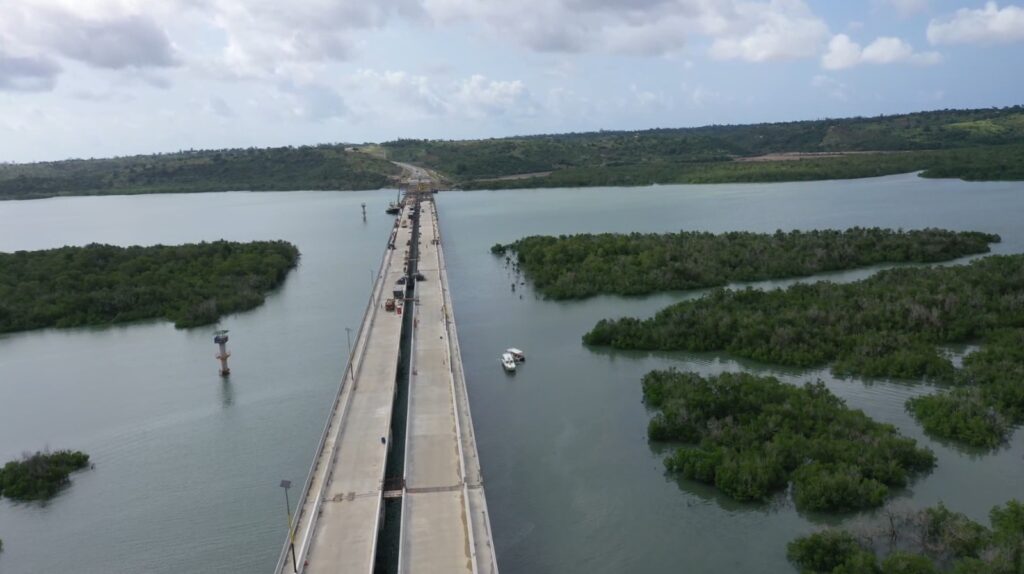
Dongo Kundu Bypass
The long awaited Dongo Kundu Bypass, also known as the Mombasa Southern Bypass, has officially opened for small vehicle traffic.
This significant development marks a milestone in Kenya’s infrastructure advancement. Hence, providing a much-needed alternative route to the frequently congested Likoni ferry crossing. However, the opening is a soft launch, and heavy commercial vehicles are still restricted due to narrow diversions along the route.
The Dongo Kungu Bypass
As the Dongo Kundu Bypass opens to small vehicles, motorists are urged to exercise caution and strictly observe the speed limits. Currently, only one side of the bypass is open, making vigilance and adherence to traffic regulations crucial for safety.
The Dongo Kundu project is designed to connect Mombasa Mainland to the South Coast without relying on the ferry services, significantly reducing travel time and easing congestion. The bypass includes three major bridges, the most notable being the Dongo Kundu Bridge, which offers a scenic route across the beautiful Kenyan coast.
Project Overview
The Dongo Kundu Bypass project has been in development for several years and is a key component of Kenya’s Vision 2030, aimed at improving the country’s infrastructure and boosting economic growth. The bypass stretches over 17 kilometers, connecting Miritini to the south coast near the Likoni-Lunga Lunga highway. It is expected to play a crucial role in enhancing trade and tourism in the region.
Phases of Construction
The construction of the Dongo Kundu Bypass has been divided into multiple phases. The current phase that has opened for small vehicles is part of a larger plan that includes the construction of the Tsunza Bridge and several other key infrastructure elements. Future phases, such as the Dongo Kundu Bypass Phase 3, will further expand the road network and improve connectivity.
Economic Impact
The opening of the Dongo Kundu Bypass is anticipated to have a substantial economic impact on the region. By providing a direct route to the South Coast, the bypass will reduce travel time, lower transportation costs. Thus, facilitate smoother movement of goods and services. This is expected to boost local businesses and attract more tourists to the coastal region, thereby enhancing economic activities.
Government and Public Response
The Kenyan government has lauded the completion of this phase of the Dongo Kundu project. Deputy Government Spokesperson Mwanaisha Chidzuga highlighted the administration’s commitment to infrastructure development, stating, “Kenya Kwanza’s government under the leadership of His Excellency President William Ruto is committed to delivering its promises and plan to the great people of Kenya. Dongo Kundu is just one of the numerous projects that have been completed and ready for public use.”
Public reaction on social media platforms like X (formerly Twitter) has been largely positive. Users have expressed excitement about the new route and shared their experiences driving on the bypass. For instance, Mohammed Hersi, a prominent figure, tweeted,
“As the Dongo Kundu Bypass opens to small vehicles (no heavy commercial vehicles for now due to narrow diversions), please exercise caution and observe the strict speed limit. Only one side is open, so caution is key. This is a soft opening.”
Mohammed Hersi
Future Developments
As the Dongo Kundu Bypass continues to develop, the focus will remain on ensuring safety and efficiency for all road users. The completion of subsequent phases will see the introduction of more robust infrastructure. Moreover, capable of accommodating heavier traffic, including commercial vehicles.
Conclusion
The opening of the Dongo Kundu Bypass marks a significant step forward in Kenya’s infrastructural development. While the current phase is limited to small vehicles, the project’s completion promises to transform travel and economic dynamics in the region. Additionally, Motorists are encouraged to drive cautiously and adhere to the speed limits as they navigate this new route.





